Mexico City Sights and Activities
Mexico City is so vibrant and so large, we simply cannot begin to name all the things to do and see in Mexico City, but here are some of the many highlights.
Chapultepec
In the Bosque de Chapultepec -- Mexico City’s Central Park of sorts -- along with fountains, lakes, walking paths, paddle boats, and lots of trees, you’ll find the
- Castillo de Chapultepec (Castle), built on an Aztec sacred hill, where Emperor Maximilian and Empress Carlota resided for a time, and heads of state lived for many years after. It’s also known as the Museo Nacional de Historia.
- world-renowned Museo Nacional de Antropología, where you can see the iconic Aztec “calendar,” giant Olmec stone heads, and other national treasures housed in architecturally impressive galleries
- Museo de Arte Moderno, exhibiting works of Kahlo, Siqueiros, Orozco, and other well-known Mexican artists from the 1920s to today
- Museo Tamayo, a modern-architecture exterior to complement its contemporary collection inside, which was a gift from Oaxacan-born Olga and Rufino Tamayo to their beloved country
- Museo de Historia Natural y Cultura Ambiental, where you can work your Spanish as you discover your prehistoric relatives or find out about recycling in Mexico
- Zoológico Alfonso Herrera, where 1800 animals representing 252 species live on 17 hectares. One hundred thirty of those species are native to Mexico.
- Jardín Botánico, that focuses on Mexico’s diverse flora.
Paseo de la Reforma
If there’s one street to know in Mexico City, it’s Paseo de la Reforma. The main artery through the Bosque de Chapultepec, designed to be the Mexican Champs-Élysées, extends to cut the city east of it diagonally.
Along it you’ll find some of the major sites, the best-known of which is the Ángel de la Independencia, that golden angel on her pedestal, icon of the city, above all the noise and chaos of the traffic below. At her feet lie the remains of several key leaders of Mexico’s independence.
Not too far from El Ángel, you’ll also stand in the shadows of Mexico’s tallest building (it was Latin America’s until 2010), the Torre Mayor, and the Mexican stock exchange, la Bolsa Mexicana de Valores, and the Roman hunter-goddess, Diana.
Farther up the Paseo, you’ll find the U.S., European Union, and Japanese embassies, among others. Closer to the Alameda, be sure to visit the Monumento a la Revolución, grand domed arches ironically started by Porfirio Díaz, the very man the revolution overthrew. The remains of Francisco I. Madero and other revolutionary compatriots are sheltered below.
If you kept following the Paseo northeast several kilometers more, you’d arrive at the Básilica de Guadalupe. This national shrine (actually there are several edifices) to the patron saint of Mexico, sits on the hill where Our Lady of Guadalupe (a.k.a. the Virgin of Guadalupe) appeared to peasant Juan Diego, leaving him with an image of her on his cloak as proof to the bishop that she wished for a temple to be built on that site.
Alameda
Paseo de la Reforma also touches a corner of the Alameda Central. The name refers to the álamos, the poplar trees that shade this centrally located park that over its history has served as a main marketplace, as the location of the Spanish Inquisition’s burning of witches and heretics at the stake, and today as a meeting, vending, and enjoyable place to walk along fountain-accented walkways.
Right next to the Alameda sits the lovely, stately Palacio de Bellas Artes. This major fine arts center boasts not only the theater where the world-famous Ballet Folklórico dances up a colorful kaleidoscope of whirling sombreros and skirts (that ends behind the majestic Tiffany-glass curtain), but also galleries, a restaurant, a bookstore, and a gift shop. Rivera, Siqueiros, Orozco, and Tamayo murals cover the walls of the upper floors, while the Museo Nacional de Arquitectura on one of these floors hosts exhibits dedicated to modern architecture.
Cross the street to take a few steps into the Palacio Postal. This marble-and-bronze, baroquely ornate palace designed by the same original Italian architect as Bellas Artes still serves as Mexico City’s central post office. A block away, treat yourself to an afternoon tea at the Casa de los Azulejos, now a Sanborns department store but with food service in the original tiled courtyard and elegant upstairs rooms.
In the Plaza de Santa Veracruz one block north of the Alameda, also check out the 16th- and 17th-century decorative pieces including silver, furniture, and textiles at the Museo Franz Mayer, whose structure boasts an equally interesting history as its contents.
Zócalo
It’s only a few pleasant blocks from the Alameda to the zócalo, the general name for the main square in any Mexican city, and the way those from Mexico City refer to the officially named Plaza de la Constitución.
From this grand plaza flies one of the largest Mexican flags you’ve ever seen. It’s also the site of the grito of independence every September 16 ("¡Viva México!"), art installations (like Spencer Tunick’s photo shoot of over 18,000 nudes in 2007), massive political demonstrations, and an ice-skating rink every winter. Get your dose of culture, history, architecture, anthropology, and more all right there at the following national jewels:
- Palacio Nacional
Dominating the whole east side of the plaza, the National Palace harbors the federal seat of executive power. Originally an Aztec palace, it was claimed and restyled by Cortés, then the Spanish crown, and then after Mexican Independence, housed different government ministries as well as a few presidents who lived there until the late 1800s. Today, federal treasury and national archives offices as well as presidential meeting rooms overlook some of the 14 patios.
Despite all that, you’ll want to go in mostly to get up close to one of Diego Rivera’s most well-known murals, the Épica del Pueblo Mexicano en su Lucha por la Libertad y la Independencia (Epic of the Mexican People in Their Struggle for Freedom and Independence). Work your Spanish listening skills on one or both of the two regularly offered tours: one of the murals and central patio, and one of architectural highlights of the regal edifice.
- Catedral Metropolitana de la Asunción de María
You can’t go to the zócalo without going into the cathedral. Built over two centuries on top of soggy, sacred Aztec grounds, the catedral’s five large gilded altars, sixteen elaborately decorated chapels, two organs, hundreds of somewhat-life-like statues of saints and various apparitions of the Holy Family, and thousands of candles in honor and thanks to them never fail to impress.
If you doubted that Mexico City was built on a swamp, you won’t after you peer down through the front “porch” of the cathedral onto where the original steps were!
- Templo Mayor
Believed to be where the Aztecs saw the eagle with the serpent in its clutches, atop a cactus -- the image of the patria on the Mexican flag -- and therefore the center not only of the capital Tenochtitlan but also of the universe, the ruins of these central Aztec pyramids were first rediscovered in the late ‘70s by city workers digging to install electric cable in that corner of the zócalo.
View the layers of original construction on the now-excavated site on which the Spanish literally built their New World empire. The museum lends a good vista both literally and figuratively to the ruins.
The other interesting buildings that line the zócalo include several museums, the former finance secretary office, and the famed national pawn shop, the Nacional Monte de Piedad.
Coyocán
Take a taxi or public transport about six miles (10km) south of the centro to wander the lovely residential streets of artsy, hip, and somewhat hippie Coyocán. Meander between the stalls of the extensive crafts market (where you’ll see plenty of signs that that the “hippie” culture is alive and well there), and rest for a bit with a coffee or ice cream on one of the two adjoining squares.
Frida Kahlo and Leon Trotsky were two of the most famous inhabitants of this colonia; be sure to visit their houses, especially the not-to-be-missed Casa Azul (Blue House) where Kahlo began and ended her life.
Other hip (but not so hippie) and chic areas of the city lie closer to the centro. Wander the tree-lined boulevards or attractive side-streets of Roma, Condesa, and Polanco, where you’ll find cute cafés and trendy boutiques (and your Spanish language school too!). In the evening you might dine at a fashionable restaurant and then go dancing at a club in the recently revitalized Zona Rosa.
Near Mexico City
-
South of Mexico City, float a lazy afternoon away on the canals of Xochimilco, the Venice of Mexico. The Aztecs filled in pads of land in the shallow lake there so that they could farm there. Today flowers mostly cover those lots, in between which canal “streets” teem with pole-propelled trajineras, the colorful, decorated gondolas of this “Place of the Flowers.”
Take advantage of your visit to Xochimilco by visiting the Museo Dolores Olmedo Patiño at the 16th-century Hacienda La Noria, where peacocks and xoloiztcuintles (pre-Hispanic hairless dog) run the flower-covered grounds. Inside, delight in the extensive collection of Diego, Frida, and cubists, but also Eastern furniture and living pieces, as well as over 900 archeological artifacts.
-

Walk along the Avenue of the Dead and climb the Pyramids of the Sun and the Moon at Teotihuacan, recently identified by Travel+Leisure as one of the top ten visited ruins in the world. There’s a reason for this distinction: These ruins, dating from 100BC, are impressive! -

For a slower-paced weekend, take a trip to provincia (what those from Mexico City call anything outside of it). Tlaxcala, Queretaro, and even larger Puebla all fit the bill of charming colonial cities with plenty to see and do, but not at the sometimes-frenetic pace of el DF.
Other Activities in Mexico City
Your Spanish language school in Mexico City also offers additional fun ways to practice your newly learned Spanish, such as dancing, cooking, and more.
Ready to take on Spanish in Mexico City? Sign up today!





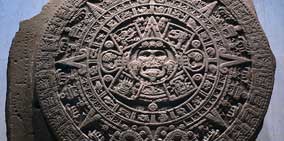
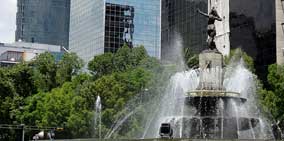
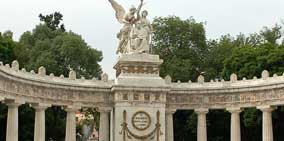
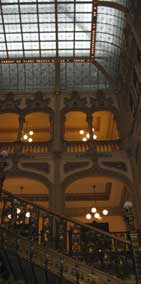
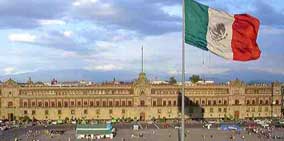
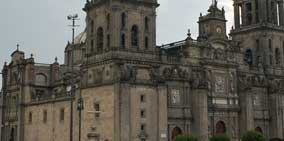
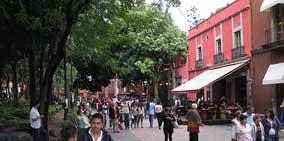
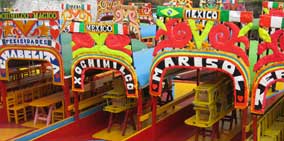
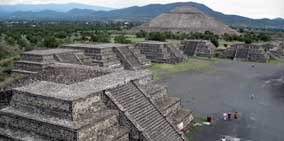

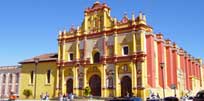
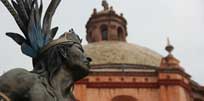

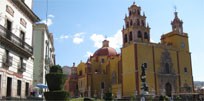
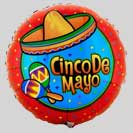 Celebrate Cinco de Mayo, commemoration day of the Battle of Puebla (1862), by learning some real Spanish -- not just the word cerveza -- south of the border. Be in impressive, colonial Puebla itself by then, or somewhere else in Mexico, to join the fiesta.
Celebrate Cinco de Mayo, commemoration day of the Battle of Puebla (1862), by learning some real Spanish -- not just the word cerveza -- south of the border. Be in impressive, colonial Puebla itself by then, or somewhere else in Mexico, to join the fiesta.